Save Up to 70% on Top Products Across Home, Kitchen,...
Read More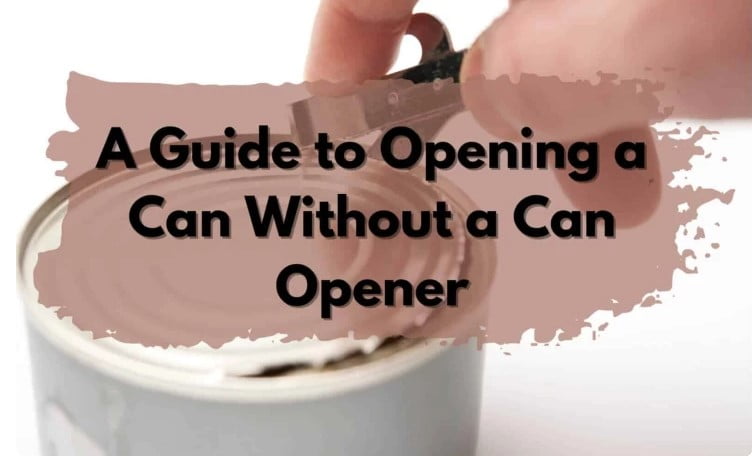
A can opener is a kitchen tool designed to facilitate the opening of metal cans, which are commonly used for packaging food and beverages. It is especially useful for cans that do not have pull tabs or other easy-open features. Can openers come in both manual and electric versions, offering different methods for safely and efficiently removing can lids.
Manual can openers typically consist of a handheld device with a rotating cutting wheel and a serrated blade. The user clamps the cutting wheel onto the lid’s edge, rotates the wheel, and the blade cuts through the lid as the user turns the handle. Electric can openers, on the other hand, use motorized mechanisms to automate the cutting process. These can openers often feature one-touch operation, making them convenient and easy to use.
Can openers play a vital role in households and professional kitchens alike, as they simplify the process of accessing the contents of canned goods. They offer a safe and efficient means of removing lids without the need for sharp implements, reducing the risk of injuries. Whether it’s for everyday cooking or emergency preparedness, a can opener is a practical tool that enhances the functionality of any kitchen.
Our Top Picks




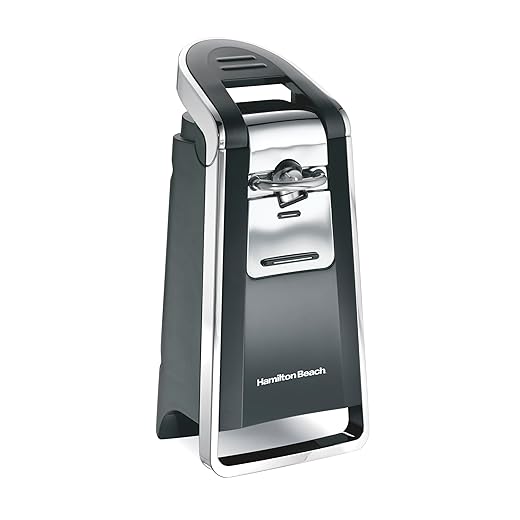



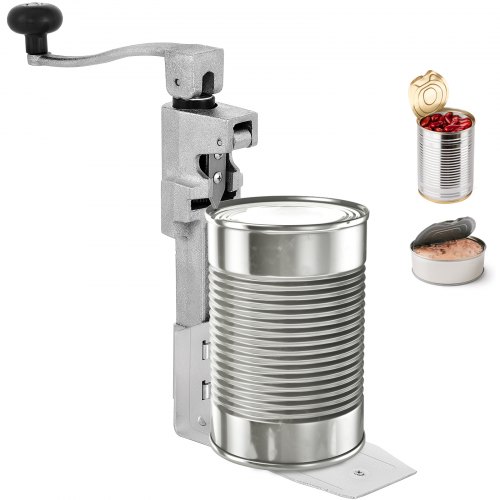

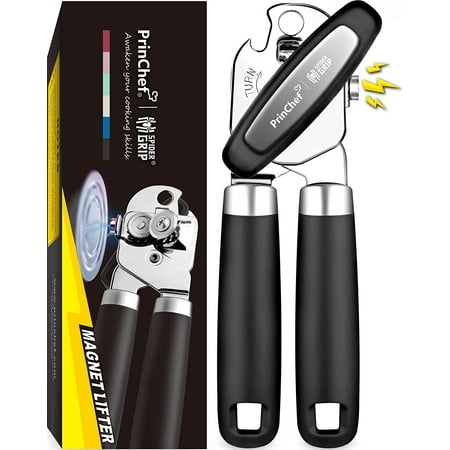
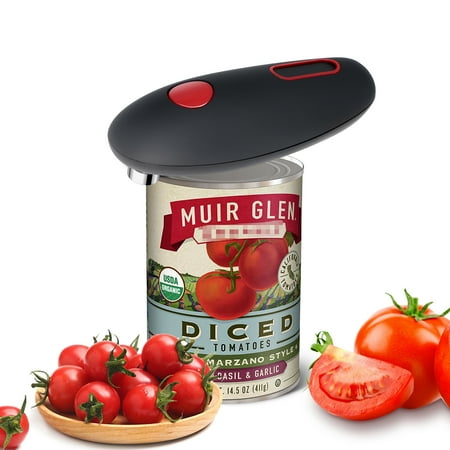
What tools can you use as a can opener?
If you don’t have a traditional can opener on hand, there are alternative tools and methods you can use to open cans. Keep in mind that these methods might not be as safe or efficient as using a dedicated can opener, so exercise caution and be mindful of potential risks. Here are some tools and techniques you can consider:
- Manual Can Opener (Puncture-and-Cut Type): Some multi-tools or survival kits include a puncture-and-cut type can opener. This tool creates a hole in the lid that can be enlarged to open the can.
- Manual Can Opener (Butterfly Type): Similar to the puncture-and-cut type, some multi-tools or camping gear might include a butterfly-style can opener. This type has a sharp blade and a rocking motion that cuts through the lid.
- Paring Knife or Chef’s Knife: A sturdy knife can be used to puncture and cut the lid open. Be cautious while doing this, as it can be challenging and potentially hazardous due to the sharp knife blade and uneven lid edges.
- Spoon or Fork: In a pinch, you can use the edge of a spoon or fork to puncture the lid and gradually work your way around to create an opening.
- Concrete Surface: If you’re in a survival situation, you can use a concrete or abrasive surface to rub the lid against until it weakens and can be pried open. This method requires patience and physical effort.
- Rock or Heavy Object: Similarly, you can rub the lid against a rough rock or use a heavy object to gradually wear down the lid’s edges.
- Safety Can Opener: Safety can openers are designed to leave smooth, non-sharp edges on the lid, making it safer to handle. These are often used in industrial or institutional settings and might be available in certain situations.
It’s important to note that using alternative methods can be more time-consuming, potentially messy, and less safe than using a proper can opener. If possible, it’s recommended to have a dedicated can opener on hand in your kitchen or emergency kit for convenience and safety.
How to open a can without a can opener
Opening a can without a can opener can be challenging and potentially unsafe. However, if you find yourself in a situation where you don’t have a can opener available, you can try the following methods. Keep in mind that these methods may not be as effective or safe as using a can opener, so exercise caution and use these techniques only as a last resort:
- Puncture and Cut Method: This method involves puncturing the lid and then cutting around the lid’s edge. Use a sturdy knife, screwdriver, or other sharp object to make a hole in the lid near its edge. Once you’ve created a hole, carefully insert the knife or sharp object into the hole and cut around the lid’s perimeter. Be cautious of sharp edges and take your time to avoid injuring yourself.
- Rock or Concrete Surface Method: Find a rough surface, such as a concrete sidewalk or a flat rock with a rough texture. Hold the can securely and rub the lid’s edge against the surface repeatedly. Over time, the friction may weaken the lid, allowing you to pry it open. This method requires patience and effort.
- Knife Blade Method: Use the blade of a sturdy knife to gradually work your way around the lid’s edge. Apply pressure and carefully push the blade against the lid, creating a cut. This method can be challenging and potentially hazardous due to the sharp knife blade and uneven lid edges.
- Spoon or Fork Method: Hold the can securely and use the edge of a spoon or fork to puncture the lid. Once you’ve created a small hole, carefully work your way around the lid’s edge, using the spoon or fork to pry it open. This method may require a lot of effort and patience.
- Thermal Expansion Method: If you have access to a heat source like a stove or campfire, you can heat the sealed lid gently. The heat can cause the air inside the can to expand, potentially creating enough pressure to pop the lid open. However, this method is not guaranteed to work and might be risky.
It’s important to emphasize that opening a can without a can opener can be hazardous, and the methods mentioned above can be difficult to execute safely. If you have access to a can opener or an alternative tool specifically designed for can opening, it’s highly recommended to use those instead. If none of these methods are feasible or safe, consider seeking assistance from someone who might have the appropriate tools.
Can you open a can with a pocket knife?
Yes, it is possible to open a can with a pocket knife, but it can be challenging and potentially unsafe. Using a pocket knife to open a can should be considered a last resort, and it requires caution and proper technique. Here’s a general method for opening a can with a pocket knife:
- Puncture the Lid: Use the tip of the pocket knife to puncture the lid near the edge of the can. Apply gentle pressure and gradually create a small hole. Be careful to avoid slipping and injuring yourself.
- Cut Along the Lid’s Edge: Once you’ve punctured the lid, use the knife’s blade to cut along the edge of the lid. This involves making small cuts while moving the knife in a circular motion. Take your time and be mindful of the sharp blade and the potential for uneven lid edges.
- Repeat and Pry Open: Continue cutting along the lid’s edge until you’ve created a complete cut around the circumference of the lid. The goal is to weaken the lid enough to be able to pry it open. You can then use the tip of the knife or another tool to carefully pry the lid up and open the can.
It’s important to note that using a pocket knife to open a can is not recommended due to the risks involved. The knife blade may slip, causing injury to your hand or fingers. Additionally, the lid edges can be sharp and jagged, making it difficult to handle the opened can safely.
If you find yourself without a proper can opener and need to open a can, it’s better to seek out alternative tools or methods, as mentioned in previous responses. If none of these options are available, consider asking for assistance or finding a safe and controlled environment to attempt the opening. Your safety should always be the top priority.
Is it safe to open can with knife?
Opening a can with a knife can be done, but it is generally not safe and is not recommended as a primary method. Using a knife to open a can presents several risks and challenges:
- Risk of Injury: Knives are sharp tools, and using them to puncture and cut metal cans can lead to accidental slips and injuries. If the knife slips or you lose control, you could cut your hand or fingers.
- Sharp Edges: When you use a knife to open a can, the edges of the lid can become sharp and jagged. This poses a safety hazard when handling the opened can, as these edges can cause cuts and punctures.
- Difficulty and Inefficiency: Opening a can with a knife requires a lot of effort and precision. It can be difficult to cut through the lid evenly, and it may take a significant amount of time and energy to complete the task.
- Unpredictable Results: Unlike using a dedicated can opener, using a knife is less controlled, and the results can be unpredictable. You might end up with uneven lid edges or partially opened cans that are difficult to manage.
Given these risks and challenges, it’s strongly advised to use proper can-opening tools such as manual or electric can openers. These tools are designed specifically for opening cans safely and efficiently, without the risk of injury or creating sharp lid edges. If you find yourself without a can opener, it’s better to explore alternative methods like seeking assistance or using available tools in a safe manner.
How else can you open a tin without a tin opener?
Opening a tin without a tin opener can be challenging, but in emergency situations or when you don’t have access to a can opener, there are a few alternative methods you can try. Keep in mind that these methods may not be as safe or effective as using a proper tool, so exercise caution and prioritize your safety. Here are a couple of methods you can consider:
Using a Spoon or Fork:
- Hold the tin securely on a stable surface.
- Use the edge of a sturdy spoon or fork to gradually puncture the lid. Apply pressure and twist the utensil to create a hole.
- Continue working your way around the lid’s edge, creating a series of holes that weaken the lid.
- Once you’ve punctured the lid sufficiently, you can attempt to pry it open by inserting the utensil and leveraging the lid upward.
Using a Rock or Hard Surface:
- Find a flat and hard surface, such as a concrete sidewalk or a large rock with a rough texture.
- Hold the tin firmly and rub the lid’s edge against the hard surface, applying pressure and friction.
- Over time, the friction may weaken the lid’s edge, making it easier to pry the lid open with your hands or a tool.
Using a Sharp Knife or Blade:
- Hold the tin securely and use the tip of a sharp knife, pocket knife, or other sharp blade to puncture the lid near the edge.
- Gradually work your way around the lid’s edge, cutting and piercing the metal. Be careful to avoid slipping and injuring yourself.
- Once you’ve created a cut around the lid’s circumference, you can try prying the lid open using the knife or another tool.
Remember that these methods can be risky and may not work well with all types of tins. Additionally, using these techniques can create sharp edges on the lid, which can be hazardous to handle. If you have the option, it’s always better to use proper tools like a tin opener, knife, or other suitable tools for the task. If you’re in a situation where you need to open a tin and don’t have the right tools, prioritize your safety and consider seeking assistance or exploring safer alternatives.
Pros and cons of using can opener
Using a can opener offers both advantages and disadvantages, depending on the type of can opener you choose and your specific needs. Here are the pros and cons of using a can opener:
Pros of Using a Can Opener:
- Convenience: Can openers make the process of opening cans quick and effortless, saving you time and energy in the kitchen.
- Efficiency: A can opener opens cans cleanly and efficiently, ensuring that the lid is neatly removed without damaging the contents.
- Safety: Can openers are designed with safety features that reduce the risk of injury compared to using alternative methods like knives.
- Consistency: Can openers provide consistent results, leading to evenly cut lids and a smoother opening process.
- Versatility: Can openers come in both manual and electric versions, allowing you to choose the type that best fits your preferences and needs.
- Ease of Use: Modern can openers are designed to be user-friendly, often featuring one-touch operation and easy-to-use mechanisms.
- Emergency Preparedness: Having a can opener on hand is important for emergency situations, ensuring that you can access canned food without difficulty.
- Multi-Tool Features: Some can openers come with additional features such as bottle openers, knife sharpeners, and cord management.
Cons of Using a Can Opener:
- Dependence on Electricity: Electric can openers require a power source to function, which can be a drawback during power outages or in situations where electricity is not available.
- Maintenance: Both manual and electric can openers require maintenance to keep them functioning properly. Cleaning and blade replacement may be necessary over time.
- Storage Space: Can openers, especially electric models, can take up valuable countertop or storage space in your kitchen.
- Initial Cost: Depending on the quality and features, some can openers may have a higher upfront cost compared to alternative methods.
- Skill Requirement: While can openers are generally easy to use, some manual can openers may require a certain level of skill to operate effectively.
In summary, using a can opener offers numerous benefits, including convenience, efficiency, safety, and versatility. However, it’s important to consider factors such as the type of can opener, its maintenance requirements, and any potential limitations. Ultimately, choosing a can opener depends on your preferences, kitchen needs, and lifestyle.
Do you really need a can opener?
While you don’t absolutely need a can opener to survive, having a can opener in your kitchen can greatly simplify the process of opening canned goods and enhance your overall cooking and food preparation experience. Here are some reasons why a can opener is a valuable tool:
- Convenience: A can opener allows you to quickly and easily open cans without resorting to more challenging or potentially unsafe methods.
- Efficiency: Can openers are designed to open cans efficiently and cleanly, saving you time and effort in the kitchen.
- Safety: Using a proper can opener minimizes the risk of injury that can occur when using alternative methods like knives or sharp objects.
- Preservation of Food and Contents: A can opener ensures that the lid is removed smoothly without damaging the contents of the can, which is particularly important for preserving the quality of the food.
- Versatility: Can openers come in both manual and electric options, allowing you to choose the type that best suits your needs and preferences.
- User-Friendly: Modern can openers are designed to be user-friendly, with features like one-touch operation, smooth cutting, and easy cleaning.
- Consistency: Can openers provide consistent results, ensuring that the lid is removed neatly and evenly each time.
- Emergency Preparedness: Having a can opener on hand is important for emergency situations where you might need access to canned food.
- Multi-Tool Functions: Some can openers come with additional features like bottle openers, knife sharpeners, and cord management, adding value to the tool.
In conclusion, while you can open cans using alternative methods in certain situations, having a dedicated can opener offers convenience, efficiency, safety, and consistent results. It’s a tool that can significantly improve your kitchen experience and is especially valuable for everyday cooking, camping, emergency preparedness, and more.
Related Posts
🌀 Waste Maid 10-US-WM-058-3B Garbage Disposal Review – Small Size, Big Power for Modern Kitchens
🌟 Quick Introduce If you’ve ever wished for a cleaner,...
Read MoreFORIOUS Kitchen Faucets with Pull Down Sprayer Review – The Perfect Blend of Style, Durability & Everyday Function
🌟 Quick Introduce If your kitchen is the heart of...
Read MoreWhy Trust Us
You will find what you are looking for at Jody's Bakery. From classic to luxury brands, you'll find both. We will help you to select appliances that fit your needs, budget and lifestyle. Whether you want to stop by to learn more — or plan to make a major purchase — we’ll treat you like family and assist you every step of the way. Shop with us today to receive friendly and experienced help along the way.













